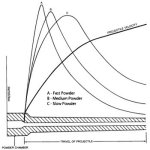Thank you. I believe this is the point I am trying to make; however dumbing things down still seem to be over the heads of some here.
I don't always need to be right and when I'm not, I don't dig in my heels and stick with my story, I embrace the new knowledge.
You made several incorrect statements some of which I
bolded above, but I realize that nothing beats a picture, so here's a chart that illustrates what I have stated in my posts.
This will probably be of no use to you, but others might benefit.
View attachment 591073
You will notice that all three powders have roughly the same Peak Pressure, but where/when it occurs differs. The faster the powder, the sooner it occurs and so on.
Even though the slow powder has its peak later than the fast powder, we're talking milliseconds later which translates into ~2-3 inches of travel. After Peak Pressure no more gas is being produced, and the smooth curve after Peak Pressure is representative of the pressure drop in a tube as its volume is increased.
There is only one example velocity curve shown, which could represent any of the powders, but if all three were shown they would differ from each other, with the fast powder producing the least velocity, then Medium, then Slow producing the highest velocity.
You'll also notice that the area under the three pressure curves increases from A to B to C, and that reflects that there is more energy being produced as more of slower powders are used which results in increasingly higher velocity.
IMO "Quickload" is largely responsible for the mistaken belief that powder burns all along the barrel well past 4", as they "calculate" "% Powder Burn". As I stated, if pressure is at or higher than where the powder is designed to operate (could be 15K psi for Bullseye and 50K psi for US869), all that will "burn" will be consumed within a few inches of the boltface. Those whose "proof" that this is not true is such things as "Muzzle Flash", or debris are mistaken. There are always by-products of combustion - some is expelled (and can result in muzzle flash), and some is left in the bore for later cleaning.
Hope this helps.







































































